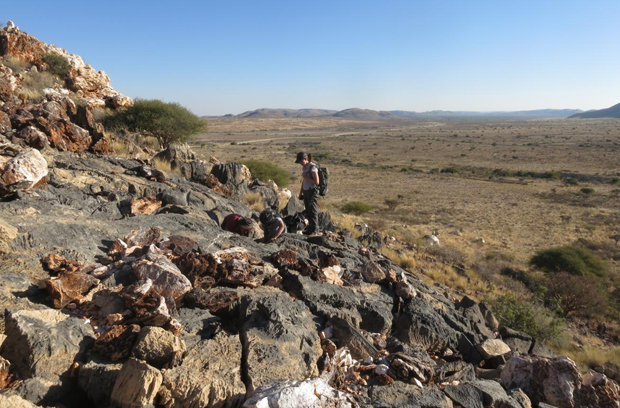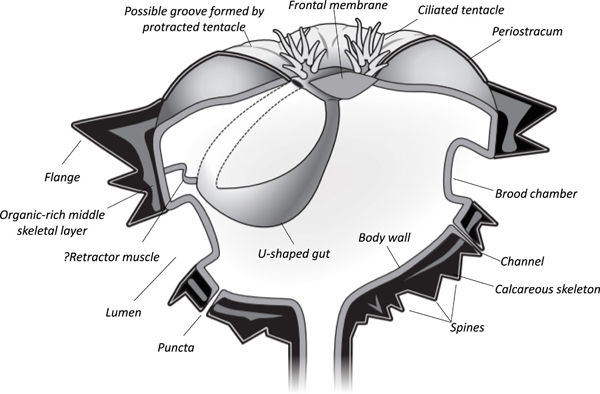Unravelling the Origins of the Earliest Animals
A team of international scientists including researchers from the University of Edinburgh and Moscow State University have used some remarkable fossils of animals that lived before the Cambrian Explosion to trace the ancestry of some of the world’s earliest organisms. The fossils, a total of 73 specimens of the primitive metazoan known as Namacalathus (N. hermanastes), were found a single bedding plane sample of rocks associated with the Upper Omkyk Member of the Nama Group of Namibia (Africa).
The Origins of the Earliest Animals
An in-depth analysis of the tiny three-dimensional fossils, the largest of which were around 12.3 mm in diameter, suggest that these animals are basal members of the Superphylum Lophotrochozoa which are characterised by having a feeding/food gathering structure that is surrounded by a ring of tentacles and a free-swimming, zooplankton developmental stage. This Superphylum includes the Brachiopoda as well as molluscs, worms and other related, generally soft-bodied organisms.
Members of the Research Team at the Fossil Site (Namibia)

Exploring an outcrop of the Upper Omkyk Member (Nama Group, Namibia). The beautiful but remote fossil site.
Picture credit: Professor Rachel Wood (University of Edinburgh)
Writing in the academic journal Science Advances, the research team report on the first known link between some of the major groups of animals that evolved during the Cambrian Explosion and their ancestral forms.
Mapping Life from 547 Million Years Ago
The close proximity of the marine deposits that contain the tiny Namacalathus fossils and an ash layer which resulted from volcanic activity permitted the researchers to accurately date the fossils to around 547 million years ago (late in the Ediacaran), the geological period that immediately precedes the Cambrian and the beginning of the Phanerozoic Eon (visible life). It is only in the last few decades that scientists have been able to piece together a picture of life prior to the Cambrian Explosion event but the fossil record for the tiny, soft-bodied creatures that dominated early marine ecosystems is exceptionally poor.
Once thought to be an ancestor of today’s jellyfishes, Namacalathus have been described as a “pin cushion on a short, hollow stalk”. The stalk is at its narrowest towards the strange cup-like structure at the top of the stalk where the feeding apparatus was located.
A Diagram of the Proposed Body Plan of Namacalathus (N. hermanastes)

A diagram showing the anatomy of Namacalathus. Measuring just a few millimetres in diameter, the 3-dimensional preservation of the Namibian specimens has permitted researchers a glimpse into the biological affinity of some of the oldest animals known to science.
Picture credit: Shore et al (Science Advances)
Commenting on the significance of this research, co-author of the scientific paper, Professor Rachel Wood of the School of GeoSciences at the University of Edinburgh stated:
“These are exceptional fossils, which give us a glimpse into the biological affinity of some of the oldest animals. They help us trace the roots of the Cambrian Explosion and the origin of modern animal groups. Such preservation opens up many new avenues of research into the history of life which was previously not possible.”
Soft Tissue Preservation and Preserved Structures
Prior to this research the exact position of Namacalathus within the Kingdom Animalia remained controversial. It had been difficult to trace the origins of the major invertebrate groups found today, as the mainly soft-bodied Ediacaran biota left only the merest hints as to their taxonomy in the fossil record.
Using advanced and sophisticated X-ray imaging techniques, the research team were able to identify some of the animal’s soft tissues beautifully preserved inside the fossils by iron sulphide. Until this paper’s publication, scientists had only ever identified exoskeleton remains of Namacalathus.
By looking at the soft tissues that had been entombed by the iron sulphide, the research team were able to identify that Namacalathus was probably a distant ancestor of today’s worms and molluscs (a basal member of the Superphylum Lophotrochozoa).
Everything Dinosaur acknowledges the assistance of a press release from the University of Edinburgh in the compilation of this article.
The scientific paper: “Ediacaran metazoan reveals lophotrochozoan affinity and deepens root of Cambrian Explosion” by A. J. Shore, R. A. Wood, I. B. Butler, A. Yu Zhuravlev, S. McMahon, A. Curtis and F. T. Bowyer published in Science Advances.
Visit the user-friendly Everything Dinosaur website: Everything Dinosaur.






Leave A Comment